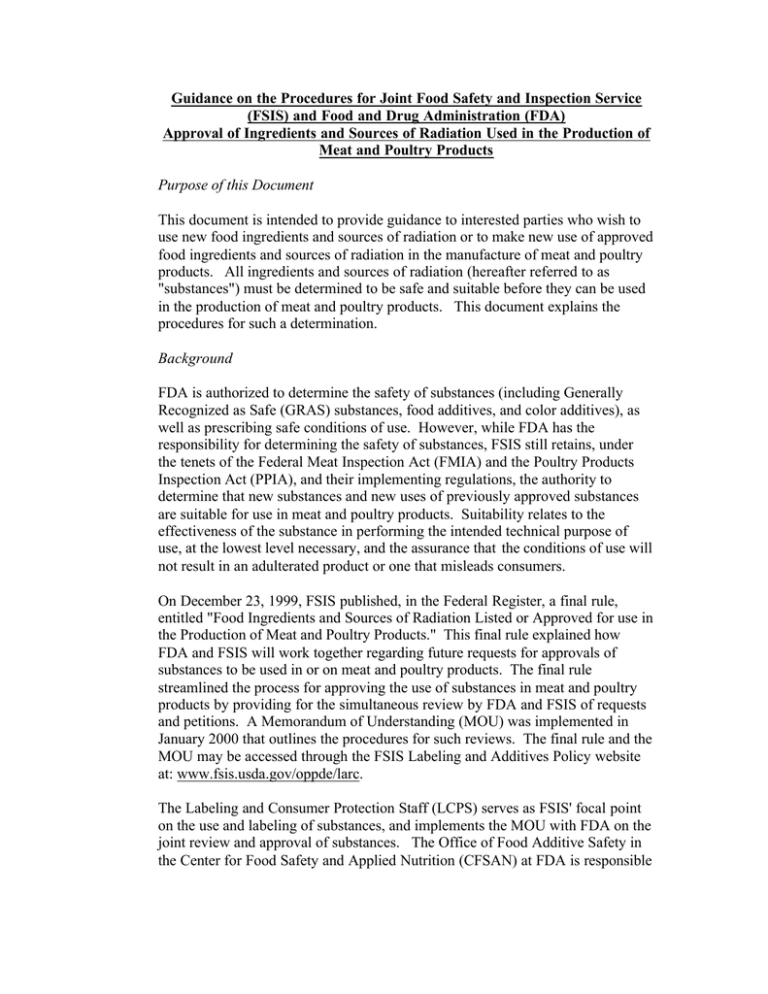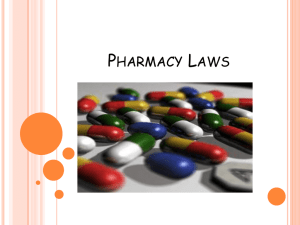Guidance on the Procedures for Joint FSIS and FDA Approval of
advertisement

Guidance on the Procedures for Joint Food Safety and Inspection Service (FSIS) and Food and Drug Administration (FDA) Approval of Ingredients and Sources of Radiation Used in the Production of Meat and Poultry Products Purpose of this Document This document is intended to provide guidance to interested parties who wish to use new food ingredients and sources of radiation or to make new use of approved food ingredients and sources of radiation in the manufacture of meat and poultry products. All ingredients and sources of radiation (hereafter referred to as "substances") must be determined to be safe and suitable before they can be used in the production of meat and poultry products. This document explains the procedures for such a determination. Background FDA is authorized to determine the safety of substances (including Generally Recognized as Safe (GRAS) substances, food additives, and color additives), as well as prescribing safe conditions of use. However, while FDA has the responsibility for determining the safety of substances, FSIS still retains, under the tenets of the Federal Meat Inspection Act (FMIA) and the Poultry Products Inspection Act (PPIA), and their implementing regulations, the authority to determine that new substances and new uses of previously approved substances are suitable for use in meat and poultry products. Suitability relates to the effectiveness of the substance in performing the intended technical purpose of use, at the lowest level necessary, and the assurance that the conditions of use will not result in an adulterated product or one that misleads consumers. On December 23, 1999, FSIS published, in the Federal Register, a final rule, entitled "Food Ingredients and Sources of Radiation Listed or Approved for use in the Production of Meat and Poultry Products." This final rule explained how FDA and FSIS will work together regarding future requests for approvals of substances to be used in or on meat and poultry products. The final rule streamlined the process for approving the use of substances in meat and poultry products by providing for the simultaneous review by FDA and FSIS of requests and petitions. A Memorandum of Understanding (MOU) was implemented in January 2000 that outlines the procedures for such reviews. The final rule and the MOU may be accessed through the FSIS Labeling and Additives Policy website at: www.fsis.usda.gov/oppde/larc. The Labeling and Consumer Protection Staff (LCPS) serves as FSIS' focal point on the use and labeling of substances, and implements the MOU with FDA on the joint review and approval of substances. The Office of Food Additive Safety in the Center for Food Safety and Applied Nutrition (CFSAN) at FDA is responsible for regulating food ingredients and additives, as well as working collaboratively with FSIS, LCPS, in the implementation of the MOU. Ingredient/Additive Classifications and the Procedures for Approval Substances added to foods are classified and defined in FDA 's regulations. The classifications include Generally Recognized as Safe (GRAS) substances, food additives (direct and secondary direct), color additives, and prior sanctioned substances. (There are also other classifications, e.g., food contact materials; however, the approval of such materials is handled on a company-by company basis by FDA.) With the exception of prior sanctioned substances, the procedures for approving ingredients and additives are described as follows: ¤ GRAS Substances (21 CFR, Parts 182 and 184) GRAS substances generally are substances for which there is consensus among the scientific community regarding their safety, and which have a history of use in foods and are derived from foods (21 CFR 170.30). There are essentially 3 ways a substance is GRAS: (a) the substance is listed by FDA in 21 CFR Parts 182 or 184 as GRAS or Affirmed GRAS; (b) the substance is determined to be GRAS by a manufacturer, supplier, or other group (i.e., a GRAS "self-determination"); or (c) the substance is the subject of a GRAS notice. In order to use new substances or consider new uses of previously approved substances, FSIS must have from FDA, at the very least, a written statement of no objection with regard to the safety of the use of the substance because the mark of inspection for meat and poultry products reflects a determination by FSIS that the food product is not adulterated, and thus that all substances used to make the product are safe and suitable. FSIS must have data that show that t he use of new substances is suitable for the intended technical purpose(s). (Refer to the Final Rule for a more detailed explanation of these requirements.) Therefore, with regard to (b) above, the use of substances that are self-determined by a manufacturer or supplier to be GRAS is not possible. With regard to (a) and (c) above, FDA receives GRAS notifications and requests to list substances as GRAS in 21 CFR. The criteria for which data are needed to support a GRAS classification (i.e., that show the safety of the use of an ingredient under the proposed conditions of use) are described in 21 CFR 170.30. Data are needed by FSIS to support the suitability of the use of the substance. The data need to show that the use of the substance is at the lowest level necessary to achieve the intended technical effect under the proposed conditions of use. Data must be provided for each meat and poultry product category in which use is intended (e.g., comminuted livestock products, such as cooked sausages, and cured poultry products, such as turkey ham). The use of new substances can not result in the products becoming adulterated or misbranded, e.g., making products look better or of greater value than untreated products or masking normal spoilage indicators. The Agencies operate in accordance with the MOU to evaluate the data jointly within the timeframes specified. Provided FDA agrees with the GRAS classification, they will issue a written GRAS Notice (also posted on the FDA GRAS website) which includes information regarding the notifier's responsibilities under FMIA and PPIA, and the related meat and poultry regulations. In the case of a GRAS Affirmation request, FDA will need to conduct rulemaking to amend 21 CFR. Acceptability Determinations About the Regulatory Status of the Use of GRAS Substances The MOU between FSIS and FDA describes a procedure whereby interested parties can request from FSIS an "acceptability determination" of whether the new use of substance in the production of meat and poultry products is safe and suitable. As noted previously, substances currently listed in FDA regulations for use in food generally (21 CFR, Parts 172-180) or GRAS for use in food (21 CFR, Parts 182 and 184) are not automatically acceptable for use in meat and poultry products, nor are "self-determinations" of GRAS possible. Unless the listing specifically mentions meat and poultry products, FSIS must have from FDA, at the very least, a written statement of no objection with regard to safety of the use of the substance. Once a written opinion is obtained from FDA, FSIS still needs to determine the suitability of the use of the substance based on data provided by the requestor that support efficacy of use. Data are needed that show the lowest level of the substance necessary to achieve the intended technical purpose. Based on the merits of the data, FSIS can permit the new use of the substance under the proposed conditions of use, and in conformance with standards and labeling requirements. Thus, not all requests for the approval of new uses of substances in the production of meat and poultry products lead to regulatory action. Rulemaking may be necessary where a standard of identity prohibits or limits the use of a substance, or the substance is not expected in the product, e.g., adding milk to hamburger. ¤ Food Additives (21 CFR, Parts 172-180) Food additives (direct, secondary, indirect) are essentially chemically derived, do not have a history of use in foods, and there is no general agreement among the scientific community with regard to their safety for the use that is proposed. Direct food additives are added to food for a technical purpose and have a lasting effect in the food (e.g., the antioxidants BHA/BHT). Secondary direct additives are added for a momentary technical effect and have no lasting effect in the food (e.g., the antimicrobial agents, ozone, acidified sodium chlorite). Indirect additives have the potential to become part of a food through processing or packaging, but are not intended to be added to food for an intended technical effect (e.g., coatings and adhesives). The approval of the use of food additives requires a great deal of scientific data in the form of petition to FDA in order to establish the safety of the substance under the proposed conditions of use, as described in 21 CFR, Part 171. Rulemaking is required on the part of FDA to amend 21 CFR. Petitions for the use of new food additives and new uses of currently approved food additives, including petitions for use in meat and poultry products, are received by FDA. FDA files such petitions publicly (i.e., in the Federal Register) if they consider them to be complete after consultation with FSIS, LCPS. Filing the petition is the start of FDA's rulemaking process. Per the MOU, FDA develops regulatory amendments in consultation with FSIS, LCPS, to amend 21 CFR. As part of the food additive petition, FSIS will require data that establish the suitability of the use of the substance for the purpose intended. The data need to show that the use of the substance is at the lowest level necessary to achieve the intended technical effect under the proposed conditions of use. Data must be provided for each meat and poultry product category in which use is intended (e.g., comminuted livestock products, such as cooked sausages, and cured poultry products, such as turkey ham). The use of new substances can not result in the products becoming adulterated or misbranded, e.g., making products look better or of greater value than untreated products or masking normal spoilage indicators. FSIS input must be provided to FDA within the timeframes specified in the MOU. All food additives must be approved for use by FDA before they may be used in meat and poultry products. ¤ Color Additives (21 CFR, Part 70) With regard to food applications, a color additive is any material (e.g., dye, pigment, lake) that, when added to a food, is capable of imparting a color. Although there is a different procedure for approving color additives, the procedure is similar to that of food additives, e.g., a petition to FDA is required for the approval of all new color additives which includes scientific data to support safety and suitability. When FDA receives petitions for the use of new color additives in meat and poultry products, according to the MOU, they consult with FSIS regarding efficacy and implications of the use in terms of the FMIA, PPIA, and related regulations. FDA must amend 21 CFR for the new uses of all color additives. The Agencies operate in accordance with the MOU to evaluate the data jointly within the timeframes specified. Prior Sanctioned Substances (21 CFR, Part 181) Prior sanctioned substances are excepted from the definition of "food additive" and are substances used in accordance with a sanction or approval granted under the Federal Food, Drug, and Cosmetic Act, Federal Meat Inspection Act, or Poultry Products Inspection Act prior to 1958. Requests for publication in 21 CFR of a prior sanction must be supported by evidence to show this. Additional Guidance Additional guidance on the procedures for the approval of substances may be obtained from the Labeling and Consumer Protection Staff at www.fsis.usda.gov/oppde/larc or at (202) 205-0279.



